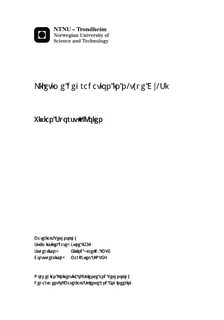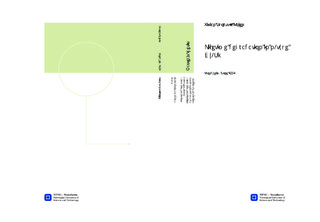| dc.description.abstract | The main object was to investigate the effect of donors, thermal donors and defects on the lifetime on n-type Czochralsky (Cz) silicon. Cz is a technique for making monocrystals by dipping a monocrystalline seed into the melt, and pulling the ingot up as the melt solidifies. Samples were prepared by sawing, grinding and polishing. Copper decoration and preferential etching was done to reveal the defects. Resistivity measurements were performed to investigate the donor distribution. The lifetime and oxygen concentration was measured.The lifetime may be influenced by donors and traps. Traps may be metallic or non-metallic. Dopants and metal contaminants are usually Scheil distributed, which typically involves a relatively stable distribution in most part of the ingot, and a rapid increase in concentration close to the bottom. Metal contaminants may be introduced from the feedstock, and dopants (either n or p dopants) are added to the melt.Oxygen is dissolved from the crucible. The oxygen concentration typically decreases with increasing length, and is controlled by the rotation speed. This was confirmed by the interstitial oxygen measurements. The oxygen concentration showed no change after heat treatment, but the presence of oxygen in itself may contribute to produce lifetime reducing agents, such as precipitates and thermal donors. Thermal donors were found in the first 18cm of the ingot. Both the resistivity and lifetime measurements was used to calculate estimated lifetimes and donor concentrations, respectively. This estimated values were compared with the measured ones, revealing that the lifetime in the ingot was SRH dominated. Thermal donors were found to have less influence on the lifetime than the trapping. Oxygen precipitations may explain the low lifetime found in the center of the ingot up to about 30cm from the crown. Such precipitations are often gathered in defect bands in the sample. CDI of a Cu decorated sample revealed a pattern of different defect densities, which also showed up at the surface of the sample after preferential etching. An H- or L- band was believed to be situated here, which both consist of small oxygen precipitates. Defects arize as a funktion of the pulling parameters, and a low growth rate was connected to the low lifetime here. Indications of the presence of non-metallic traps were found throughout the ingot. However, oxygen precipitates could not explain the non-metallic traps that was found on the outside of the ingot, and the cause of these is therefore unknown. It is however likely that these traps may be connected to the pullrate/temperature gradient-ratio. Most likely metallic traps were also present. It is uncertain whether the non-metallic or metallic traps were the most important to the lifetime of this ingot, as the relative distribution of the two cannot be decided with certainty from the results in this thesis.Contrasts in CDI and steep curves using PCD measurements vs length plots were believed to be due to the lifetime degrading agent that changes the fastest. Metallic traps and the phosphorous dopant are known to be Scheil distributed, hence they appear transparent for the lifetime measurements in areas where the distribution is stable. Thermal donors and non-metallic traps are thus more likely to create contrast in the top parts of an ingot. However, it is not necessarily the phenomenon that causes the contrast that is the major lifetime degradation contributor. | nb_NO |

